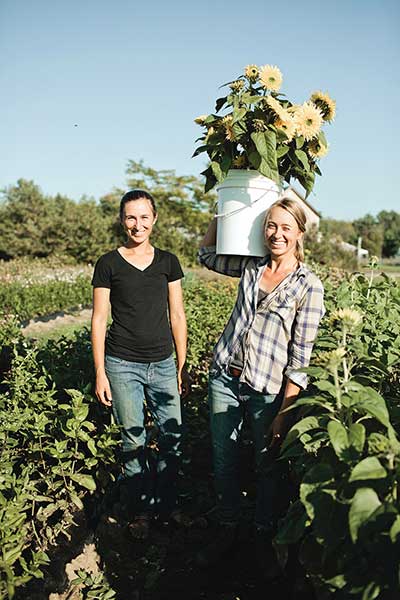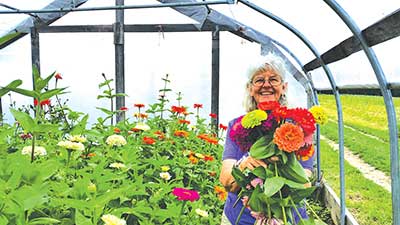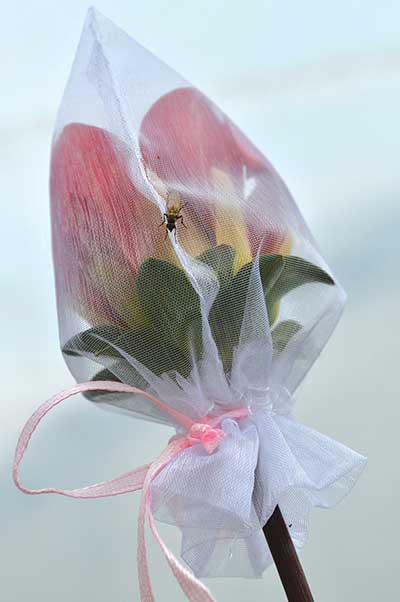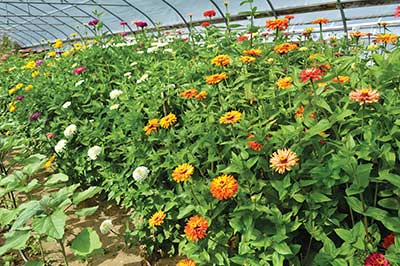 |
| Lauren (left) and Carole Mapes of Flywheel Flowers. Photo by Ashley Jardim, She of the Woods, sheofthewoods.com |
 |
| Karen Volckhausen. Photo courtesy of Happy Town Flowers |
 |
| Dahlia flower protected from tarnished plant bug by an organza gift bag. English photo |
 |
| Zinnias grow tall in a hoophouse at Happy Town Flowers. English photo |
By Jean English
This session at MOFGA’s 2018 Farmer to Farmer Conference featured three growers at different stages in their farm businesses: Stacy Brenner of Broadturn Farm in Scarborough, Carole Mapes of Flywheel Flowers in Unity and Karen Volckhausen of Happy Town Farm in Orland.
Broadturn Farm
John Bliss and Stacy Brenner lease about 150 acres and several buildings on the 434 acres owned by the Scarborough Land Trust. Broadturn started a produce CSA about 18 years ago. The farmers still wholesale certified organic produce but ended the CSA about two years ago because of the growth of the flower business. Now Stacy does flowers for weddings and funerals; sells flowers wholesale to other designers and to Rosemont Market; sells bouquets and single-stemmed bunches (one variety in a bunch) to a handful of locations, with Whole Foods as her largest customer for those; and sells bouquets to a few restaurants and hotels once or twice a week. She has an online store for home delivery and recently opened a flower shop in Portland.
Her 3 acres of flowers grow in 400-foot-long plastic-mulched beds and are processed in her studio. Landscapers deliver leaves, which the farmers apply with a manure spreader. They then move the leaves into walkways with a push broom. The flowers aren’t certified organic because Brenner can’t find untreated seed for many varieties, and she sometimes buys clumps of varieties that are hard to grow.
Broadturn’s mission – to grow community through farming, build soils to last a lifetime, and teach and learn with others – has carried them through all the incarnations of their business, said Brenner. They want to ensure that they can provide flowers to people of all economic levels. Through its flower recycling program, Broadturn deliver bouquets to about 10 places, including a publicly funded assisted living facility, a domestic violence safe house and a couple of recovery homes. “We offer all our full-design clients the option of paying a small additional fee that we use to cover the labor of repackaging and delivering their arrangements to these locations as a way to share the flowers and allow more people to enjoy them,” said Brenner.
“The number of plant families you’re producing with a cut flower farm is much larger than in the vegetable world,” she continued. They include the Asteraceae (most of the annuals – zinnia, sunflower, cosmos), Plantaginaceae (snapdragons, digitalis, veronica) and many perennials and bulbs. Otherwise, building soil fertility and treating pests is the same as with vegetable cultivation.
Through the Seasons
Brenner’s year of flower growing starts with spring-blooming bulbs planted in the fall – tulips, ranunculus and anemone. About 30,000 tulips are planted; they don’t need fertilizer but just a little organic matter and a nicely prepared bed so that they grow well and are easy to pull. “Put them in and then harvest the whole bulb,” twice a day in tulip season, said Brenner. “Lay them flat in crates and put the crates in the cooler with the bulb on them. You can store them in the cooler for about two weeks,” where the stem grows about half an inch. “When you’re ready to go to market, cut the bulb off.” Weeding is too labor intensive if bulbs remain in the ground. The flowers are easy to sell and hit Mother’s Day perfectly. “We choose specialty varieties” including Parrots, double earlies and double lates, “and stay away from the simple, single tulips when possible because we can’t get the price point down low enough for them.”
Ranunculus, said Brenner, needs a perfect, consistent day length and 65 F, which is hard to achieve in Maine’s short springs. She said to soak the corms for 24 hours in a bathtub with the water (at well temperature) running, pot them into 50-cell flats and transplant them into a hoophouse after they’ve sprouted, in February. Cover them with row cover and plastic. This year she planned to heat her hoophouse minimally to try to avoid Pythium. Ranunculus blooms around Mother’s Day, but Brenner hopes to push them a little earlier this year.
Anemones grow similarly but are a little more cold-tolerant than ranunculus. Wedding designers currently want the white ones, said Brenner, while brighter colors sell better at market.
Spring-blooming herbaceous perennials often aren’t harvested until their second year. Add bleeding heart to a vase or sleeve of flowers, and you’ve added $3 to $5 to the arrangement, said Brenner. Divide the prolific clumps as they enlarge. “One of our strategies for weeding perennials is to dig the whole bed with the root lifter, divide it and move it to a clean bed,” she noted.
Late spring/early summer herbaceous perennials include peony and echinacea. The latter bloom in spring and again all summer. Tiny echinacea flowers that aren’t quite blooming yet are sturdy enough for boutonnieres, she added. In the fall, Brenner removes the petals and uses the cone.
“Everybody love peonies,” said Brenner. “You can never not sell them.” They come in may colors and types and have a great vase life. Harvest them in the soft bud or marshmallow stage and store them in a cooler for three to five weeks, not in water. Just before market, cut the bottom of the stem and put it in water.
Woody perennials for spring and summer cuts include ninebark and ‘Limelight’ hydrangea. Fast-growing ninebark (Physocarpus) comes in green, dark purple and orange-red varieties. First-year stems are straight, but in spring of the second year their growth arcs with beautiful clusters of flowers, said Brenner. The tips can be hard to hydrate in spring, she added, so consider hydrating to keep them from wilting, or trim off the tops, or wait until a little later in the season when the stems don’t wilt so fast. The foliage and pods are attractive in arrangements. You can cut the plant back to about 2 feet every summer.
‘Limelight’ hydrangea stays creamy green longer when grown in the shade; exposed to sunlight, it starts blushing sooner.
Spring shoulder-season annuals for tunnels include snapdragons and stock. Start snapdragons from seed in a greenhouse in January, put them in a covered hoop structure in late March or early April, and harvest by the Mother’s Day window. “‘Madame Butterfly’ from Johnny’s is beautiful,” said Brenner, but it comes only as a mix, while growing single colors together simplifies harvesting. Support snapdragons with Hortonova netting to prevent excess swaying. “I love the bent snap for design work, but you can only sell so many,” said Brenner. Stock, a Brassica, struggles with flea beetles, she added.
Annuals to grow from seed and succession transplant every two to three weeks for summer bloom include cosmos, zinnia, celosia, sunflower, nigella, rudbeckia and scabiosa. Deadhead them if possible, said Brenner, but cosmos takes less time to succession plant than to deadhead. “We love the doubles.”
Zinnias – ‘Cupcakes,’ ‘Queen Red Lime’, ‘Benary’s Giant’, ‘Persian Carpet’ – all are great, said Brenner. The first stem is short, so cut it and sell it in a jar or in a small arrangement. Then the plant starts branching. ‘Persian Carpet’ is short.
Sunflowers – Grow single-stem, daylight neutral sunflowers, Brenner advised. Don’t grow branching varieties, which are beautiful but not productive enough. Choose varieties that don’t shed petals or drop pollen. Harvest when they’re just beginning to open and showing a touch of color for maximum vase life and so that they travel better in a cooler. Open petals get bruised and start to fall off.
Rudbeckia comes in many colors; varieties with double petals are beautiful.
Nigella – ‘Transformer’ is a great variety. Brenner sows two or three nigella seeds per cell in Japanese paper pots and doesn’t thin them, so they grow in a clump with taller, straighter stems.
Fall flowers include dahlias and chrysanthemum. Choose dahlia varieties that work and sell well at market. ‘Café au Lait’ is hard to grow; it shows rain spots; and corn borers, tarnished plant bugs and leafhoppers love it, but customers love it too and will pay $4 per stem at some markets. Ball types are much easier to work with. Brenner saves dahlia rootstock over winter.
Early mums are fun to grow, said Brenner. She buys tiny cuttings, pinches them, pots them into soil, and in late June or early July loads the cuttings into the hoophouse. They grow with minimal light and need a temperature of only about 40 F. She is done with them by mid-December.
Proteknet is Brenner’s main insect control method, followed by rotation and cover cropping.
Resources include Johnny’s Selected Seeds for seeds, equipment and the cultural information in its catalog; Gloeckner/Ednie for plugs, bulbs, tubers and seeds; Germania and Geo Seed for seeds; Farm Bailey Plugs for plugs and for its great website; Pierson’s Wholesale Nursery in Dayton, Maine, for woodies; Van Engelen for bulbs; DeVroomen for bare-root perennials; and King’s Mums.
Flywheel Flowers
Carole Mapes has been farming in Maine for six years, including being MOFGA’s farmer in residence in 2017 and 2018. Her sister, Lauren, helps part-time, including doing most of the dried flower work. Now that her farmer-in-residency is up, Carole will continue Flywheel Flowers by leasing land and a house near Unity that has farming infrastructure and good soil.
She does all of her sales through Square and was surprised to find that 50 percent of sales came from farmers’ markets (Mount Desert Island, Northeast Harbor and Bar Harbor). Dried flowers account for 25 percent of sales (mostly during the Common Ground Country Fair), so she and Lauren are adding the Bangor Harvest Festival and a couple of other events; 20 percent of sales are wholesale, mostly to florists; and a few restaurants are customers.
The book “Postharvest Handling of Cut Flowers and Greens,” published by the Association of Specialty Cut Flower Growers, has been especially helpful, as has the ASCFG online forum and Facebook group.
The sisters currently transplant almost everything, and transplant into black plastic. They cover cropped the aisles with clover and oats, which reduced dust during the dry period last summer.
They harvest into clean buckets, which is very important for organic production, said Mapes. This year she bought two 50-gallon tubs and a sprayer hose. Each Monday, after farmers’ market, they sprayed the buckets with water and then put them in the tubs containing water and bleach, scrubbed them again using a scrubber that would not scratch the buckets, put them into clean water again and then dried them on a table before stacking. When Mapes mentioned the occasional difficulty of separating stacked 5-gallon buckets, Brenner suggested directing pressure from an air hose between them.
Always prioritize trellising, said Mapes. She initially sets 6-by-6-inch square Hortonova at soil level and uses this grid to plant into – e.g., for stock or snapdragons, one or two plants per square, depending on desired spacing.
For more efficient harvest, Carole and Lauren bulk harvest such flowers as stock, snapdragons and larkspur. One person cuts a bunch and takes it to a table or tailgate, where the other strips the foliage. They strip single-stemmed sunflowers while the flowers are still on the plants and then cut the stems and put them in buckets.
These were Mapes’ top crops for farmers’ markets:
- sweet peas – especially for people who walk up to the table to smell them. ‘Nimbus’ from Uprising Seeds in Washington, which sells only organic flower seed, is her favorite variety for its blue color. She also likes ‘Mollie Rilstone’, ‘Bristol’ and ‘Carlotta’ from Swallowtail Gardens or Floret. These early season flowers are easy to sell at farmers’ markets, when people are ready for any color you can offer.
- tulips. Flywheel is leaning toward the parrots and doubles this year.
- zinnias – especially ‘Benary’s Giant’ and the ‘Queen Lime’ series from Johnny’s or Geo.
- stock – especially single-stem types and the ‘Iron’ and ‘Katz’ series, which must be trellised. When the weather warmed, the ‘Katz’ seemed to stretch and the ‘Iron’ seemed to stay more compact and had a nicer flower.
- snapdragons – including ‘Madam Butterfly’ and ‘Overture Orange’. These bloom right after sweet peas and are in Flywheel’s mixed bouquets, which are a lot of work. Other favorites include Icelandic poppies, ranunculus and dahlias.
These were her top crops for wholesale (mostly to florists):
- sunflowers – “maybe because we had them for such a long time,” said Carole. They grow the single-stemmed ‘ProCut Series’.
- snapdragons
- sweet peas
- Icelandic poppies, including ‘Pastel Meadows’ from Uprising Seeds. Mapes plants this around the third week of October; it overwinters and then flowers early.
- anemones
These are the top dried flower crops:
- statice – “You can put it in a wreath by itself and people will buy it,” said Mapes. “It grows well and is easy to harvest. We put it in super early and on white plastic to try to stretch the season. We can never have enough of the white or apricot. This year we added light blue, which goes well with any yellow.”
- straw flowers – Harvest them before they open, since they keep opening as they dry.
- grasses – These are good for big wreaths or bunches, individually or as mixes. ‘Ruby Silk’ grass adds a nice texture to almost anything, said Mapes. Broom corn is easy to grow and doesn’t have to be stripped but is just cut and dropped into a bucket. Bromus grass is also useful.
- herbs – Carole and Lauren make wreaths with softneck garlic, common sage, lavender (‘Ellagance Purple’ flowers stand out and look good in individual dried bunches) and rosemary (from plugs from Johnny’s; they prefer ‘Gorizia’ over ‘Perfect Skewer’ because the woody stem of the latter doesn’t work so well in dried arrangements).
- pods – of nigella (aka love-in-a-mist, especially ‘Albion Black Pod’ and ‘Albion Green Pod’), breadseed poppies and scabiosa (starflower).
In addition, ‘Sunday Gold’ celosia works well with all of the fall colors; and ‘Flamingo Feather’ is another favorite celosia. Carole and Lauren grow “tons of garlic” – mostly softneck for braiding, although they do braid stiffneck as well. They don’t grow a lot of Sweet Annie artemisia, but Carole said that people are always looking for it.
Happy Town Flowers
Karen and Paul Volckhausen own MOFGA-certified organic Happy Town Farm, and within that farm Karen runs Happy Town Flowers. “You can grow flowers on a small scale and make money at it,” she said. Karen grows one-quarter acre of flowers, uses simple systems and simple tools, delivers within a 25-mile radius and knows her customers.
The Volckhausens initially grew only vegetables commercially, but as Karen’s flower gardens around the house increased from one to 10, she decided to sell flowers. She was still working 40 to 60 hours per week as a nurse practitioner, so in addition to sending flowers to market, she brought little vases of flowers to her workmates, who became part of her customer base. When she started nursing part-time, she added two flower CSA programs, and when she retired in 2009, her flower business grew again. Now she sells at four farmers’ markets, to one florist, several churches, an art gallery, weddings, small events and 18 to 20 CSA customers.
She begins seeking organic seed when catalogs start arriving in November. Organic seed is increasingly available from Johnny’s, Harris and other companies, Volckhausen said.
She starts her first seeds in February in a germination room in a storage shed. Flats sit on a plant stand and receive full-spectrum light. She uses Vermont Compost potting soil because its fertility lasts at least eight weeks. Then plants move to a heated greenhouse with a cement floor. The Volckhausens have five hoophouses, including one for flowers, so they can rotate crops in those. Karen starts more plants in the hoophouse in April, and the Volckhausens try to plant cover crops in their hoophouses each fall. Hortonova works great with zinnias, she said.
Pests include stink bugs, tarnished plant bugs, lily leaf beetles, Japanese beetles, aphids and more. Netting the hoophouse with Proteknet is the first line of defense. The smallest mesh is needed to exclude flea beetles. Last year the Volckhausens did not net the hoophouse, so tarnished plant bugs got in. Karen excluded them by putting drawstring organza gift bags, from Amazon, around individual dahlia flowers. The 4-by-6-inch was the most useful size, she said. After netting, pest solutions include beneficials (ladybeetles and green lacewings for aphids), deterrents, and, last, spraying (including Pyganic and neem oil for stink bugs on Bells of Ireland last year).
Volckhausen has hired one helper for the past three years, and two of her flower CSA customers can each get a bouquet if they work for two hours.
To extend cut flower life, Volckhausen uses Vita One-Step Hydra and Nutra solution, and she keeps flowers in a cooler until they go to market.

